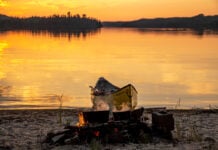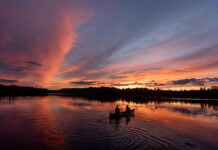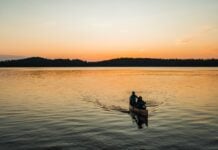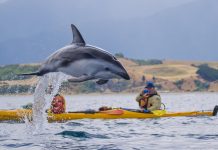I’m drinking coffee on a seaside rock on Knight Island, Prince William Sound, Alaska. From the velvety fog comes a surprisingly loud crunch. It continues for twenty seconds. Then it stops. Ten seconds later the crunching noise resumes for another half-minute. The pattern continues.
I know the sound, although it’s been missing from my home state of Oregon for more than a century. It’s a fuzzy, adorable and hungry sea otter. The crunching noise is it cracking urchin, crab, clam or mussel shells, and munching on shellfish. The brief silences are when it dives for more grub. Sea otters eat a lot. Their appetite makes them an ecological keystone. And a movement is gathering steam to return them to the Oregon coast.
Otters’ undeniable cuteness, appetite, ecological importance and near-extinction are all linked together. They once ranged from Baja to Japan. Their thick, plush fur led them to be hunted relentlessly, disappearing from much of their range by the early 1900s. Their fur is so thick because they lack the blubber other marine mammals use to keep warm. It also means they need to eat a lot to keep pumping out the BTUs.
“Otters eat about 25 percent of their weight in shellfish every day,” says Bob Bailey of the Elakah Alliance, the organization spearheading the otters’ return to Oregon. “For an 80-pound otter, that’s three and a half tons of shellfish a year.”
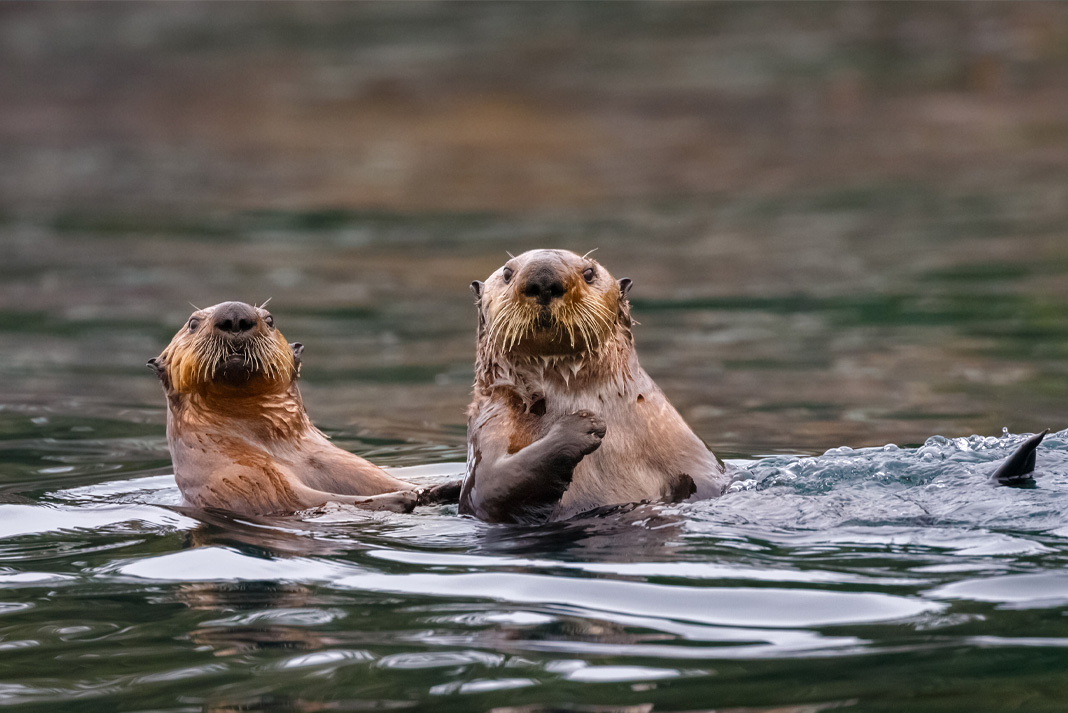
A relentless appetite means sea otters have an outsized influence on marine ecosystems. In the absence of hungry otters, urchins munch through kelp, seagrass and eelgrass beds, creating vast urchin barrens where there were once productive nurseries for fish. Where otters survived or were successfully reintroduced, the kelp forests have come back. Otters survived in areas of Northern California and Alaska, and were reintroduced to the west coast of Oregon, Washington and British Columbia (B.C.). The Washington and B.C. populations survived. The Oregon population did not.
There are plenty of reasons to bring back otters. They’re cute, and as any kayak guide in Monterey, California, can tell you, cute otters equal tourism business. Healthy kelp forests and seagrass and eelgrass mean more fish for commercial fishermen, Orca and local residents alike. Kelp, freed from urchin munching, grows fast and sucks up carbon dioxide. By one estimate, otter-restored kelp forests store 8.6 billion kilograms of carbon, worth $408 million on the European Carbon Exchange.
“Come for the cute, stay for the carbon,” says Jules Bailey, a former Oregon legislator.
I’ve paddled with otters on the B.C. and California coasts. They make the coast come alive, popping up in kelp beds and sleeping together in giant rafts. When I came across one snoozing group, most dove, but one pup decided to head-butt my kayak bow first. I desperately want them back on the Oregon coast.
But there’s more to do than just scooping up a few cute fuzzy Alaskan otters and letting them loose in Oregon. The Elakah Alliance is launching a two-phase process. Phase one is a feasibility study. Where are the best spots, with enough shellfish, offshore rocks for kelp to adhere to, or estuaries with seagrass beds? Since Oregon was the transition zone between northern and southern sea otter subspecies, how many animals of which type? How many otters are needed to survive and spark a new population? What gender mix? The ripple effects of new changes, like warming oceans and the stress on shellfish of ocean acidification from greenhouse gasses—are hard to predict but make otters even more critical.
“The nearshore ecosystem is already under stress, and we’ve been living on borrowed time,” says Bailey. “Returning otters and kelp forests is something we can do and will build the ocean’s resilience to coming changes.”
The second part of the plan is the human element. Bailey, a retired coastal planner, is planning an economic analysis, looking at the ripple effects otters could have on fisheries, tourism and coastal communities, many of which have been smarting from a long-running decline in timber jobs and declining fish populations.
“The approach is consensus-based,” says Avalyn Taylor, an Elakah board member. “It’s an opportunity to right a past wrong in a very tangible way,” she says. “Otters could be back within my kids’ or grandkids’ lifetime.”
Sitting on my rock in Alaska, listening to otters munching away as the Chugach Range slowly emerges from the fog, I’m hopeful it won’t take so long.
Neil Schulman writes and paddles in Portland, Oregon.
This article was first published in Paddling Magazine Issue 62. Subscribe to Paddling Magazine’s print and digital editions here, or browse the archives here.
Otters are part of the Mustelidae family, which includes skunks, weasels, wolverines and badgers. The sea otter is the largest member of the weasel family, but the smallest marine mammal in North America. | Photo: istockphoto.com



